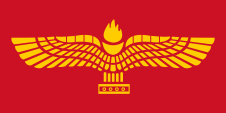mobile View, to the German Version tap the flag


- Nation and Christian religious community in the Mideast Region
• Flag
• Meaning/Origin of the Flag
• Additional text

Flag of the Arameans,
Source, by: www.suryoyosat.de




When the flag of the Arameans was created is not known, certainly after the christianization of this nation. The central golden picture in the middle of the red flag shows an eagle. That symbol is in this pattern even very old. It was already in the Old Egypt a symbol for the sun or the Spirit's Sun. The shape of the flag goes back to an archaeological find in Tell Halef, but the flame at the head of the eagle has been added in the 70s of the 19th century. At this place, was previously placed bevor the head of the god Assur. The colors come from the 19th century, too. In the 30s the Chaldo-Assur Army used a red-yellow flag and in the 60s these colors got folkloric significance. About the meaning of the colours is nothing known. The initial moment in the creation of the eagle-symbol was probably the corona of the sun during a solar eclipse. They meant to see behind the sun a further sun, the Divine Spirit's Sun. The form of the corona remembered in this moment obviously an eagle and that eagle-symbol arised. Frequently this eagle was connected with the portrayal of the sun. In this way carryed this eagle in the Old Egypt a sun on the head or on the chest and was frequently escorted by two lions. The Phoenicians took over that symbol completely, the Persians only the eagle. The Phoenicians gave the eagle-symbol with the sun to the Arameans and the Old Chaldeans (likewise an Aramaic people). Sun and lion were tooken over by the Punians and Macedonians. As in Persia spreaded out the tenets of Zarathustra (between the 11th and 6th century B.C.), the sun-symbol on the Persian eagle was substituted by an image of Zarathustra (Greek: Zoroaster). The eagle was later tooken over by the Romans, the lion changes from the Macedonians to the Slavs and the sun arised later as symbol at the Kurds. From the Old Chaldeans the eagle was given to the Assyrians, but whose history ends in the 7th century B.C. As the Christianity spreaded out within the Arameans the Christian Arameans maintained the eagle, but the sun-disk was substituted by a stylized torch. It stands for the fire of the Holy Ghost and is a Christian symbol.
Source: partial source and surf tips:
1. www.suryoyosat.de
2. Severyos Oers,
a.) bethnahrin.de,
b.) bethnahrin.de

The Arameans belonged mostly to the Syrian-Orthodox Church and they are today named also as Syrian christs. They name itself Oromoye (Arameans). The Arameans are divided in two groups: The Eastern Arameans (self-denomination: Ashuroye = Ashurits) and the Western Arameans (self-denomination: Suryoye = Syrer, a word which originally descends from the Greek language). The severance between the Eastern and Western Arameans was made ca. 400 B.C. The in the influence of the Byzantian Empire remained Arameans (Western Arameans) maintained the denomination of Suryoye, while the in the influence of the Persian Empire of the Sassanides comed Arameans (Eastern Arameans) took over the denomination of Ashuroye. The Western Arameans belonged moreover to the "Syrian-Orthodox Church of Antiochia", while the Eastern Arameans went to the "Holy Syrian-Apostolic Church of the East" (Nestorians resp. Thomas-Christs) übergingen. As Europeans roamed through the Middle East (partially in evangelical mission) was the word "Ashuroye" not translated with "Ashurits" but with "Assyrians". In ethnological sight a big mistake. Unfortunately the word "Assyrians" was tooken over and maintained by the Eastern Arameans. In this way is it possible to believe that the Old Assyrians exist until today. Equally name some Western Arameans itself as "Assyrians" and confusions and complete deformations of sense are easily possible. Even at the Eastern Arameans the eagle arises again but he shows instead of the sun the head of the Old Assyrian god Assur (!), often together with a pale-blue four-pointed star. That star stands symbolic for the Star of Bethlehem and represents the "Spiritual Cross" or even the name of Jesus.
Source: 1.) Wikipedia (D),
2.) Wikipedia (D),
3.) Volker Preuß


![]()




